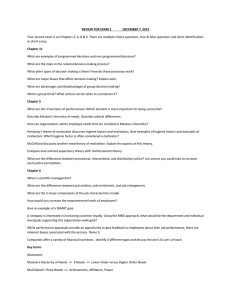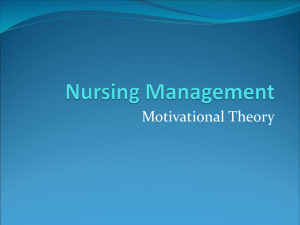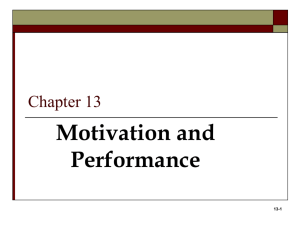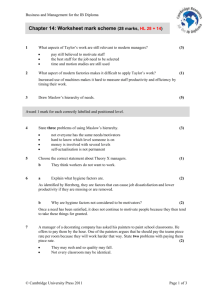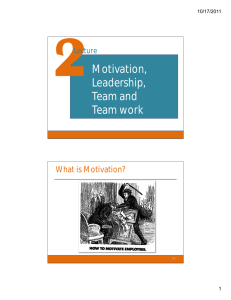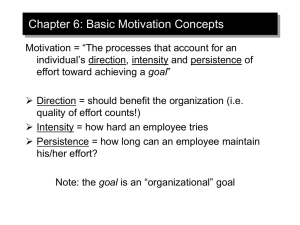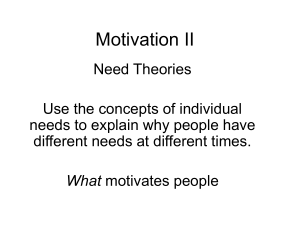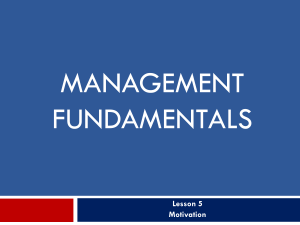motivation - Govt College Ropar
advertisement
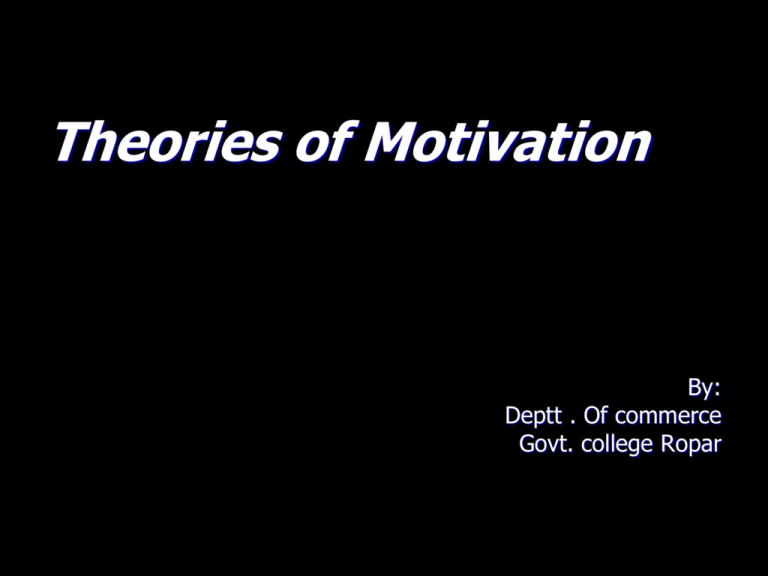
Theories of Motivation By: Deptt . Of commerce Govt. college Ropar MOTIVATION Motivation is an important factor which encourages a person to give their best performance and helps in reaching enterprise goals. The term motivation is traced from the Latin word movere which means to move. Motivation is an inner drive to behave or act in a certain manner. Ability* Motivation*environmental condition = Performance Types of motivation INTRINSIC MOTIVATION It is an internal motivation It occurs when people are compelled to do something out of pleasure, importance or desire People engage in an activity for its own sake. EXTRINSIC MOTIVATION It occurs when external factors compel person to do something. It includes circumstances, rewards or punishment both tangible & intangible. POSITIVE MOTIVATION it is based on reward Workers are offered incentives for achieving desiring goals It is achieved by cooperation of employees NEGATIVE MOTIVATION It is based on force and fear The fear acts as a push mechanism This type of motivation causes frustration & anger CONSCIOUS MOTIVATION These are those motivation that are willful and we are aware of it. It is internal to every human being. UNCONSCIOUS MOTIVATION we are not aware of it. It may be the result of anxieties. THEOREIS OF MOTIVATION The human nature is so complex that it responds unpredictably at different times. The motivators differ from time to time, place to place, and situation to situation. The same set of factors may motivate some persons but not all. so it is very difficult to give a specific theory, which will be universally accepted. APPROACHES TO EXPLAIN MOTIVATION APPROACH THEORIES Need Based Approach •Maslow’s Need hierarchy theory •Alderfer’s ERG theory •Herzberg’s 2 factor theory •McClelland’s 3 need model Cognitive Process Approach NON Cognitive Approach •Expectancy theory •Goal setting theory •Social learning theory •Equity theory •Reinforcement theory A. MASLOW’S NEED HIERARCHY THEORY A.H Maslow an American scientist has given a framework that helps to explain strength of certain needs. He categorized human needs into five categories. I. V. Physiological Needs II. Safety Needs III. Social Needs IV. Esteem Needs Self-actualisation Needs He is of the opinion that a person tries to achieve the first and then moves on to next after being satisfied. B. ALDERFER’S ERG THEORY Clayton Alderfer, expanding on Maslow’s hierarchy of needs, created ERG theory. Level of need Definition Properties Existence Includes all the various forms of materials and psychological desires. When divided among people, one person’s gain is another’s loss is recourses are limited Relatedness Involves relationships with the significant others Satisfied by mutually sharing thoughts and feelings acceptance, understanding. Impels a person to make creative or productive effects on himself & his environment. Satisfied through using capabilities in engaging problems, creates a greater sense of wholeness. Growth C. HERZBERG's TWO FACTOR THEORY Fredrick Herzberg's two factor theory i.e. intinsic/exrinsic motivation concludes that certain factors in workplace result in job satisfaction but if absent they doesn't lead to satisfaction. Motivating factors Hygiene factors • challenging work •Recognition •responsibility • status •Job security •Salary •Fringe benefits D. McClelland's 3 NEED MODEL According to McClelland a person acquires 3 types of needs as a result of one’s life experience. Dominant Motivators Characteristics of the person Achievement •Has a strong need to set & accomplish challenging goal •Takes calculated risks •Likes to receive regular feedback on progress Power •Wants to control & influence others •Likes to win arguments •Enjoys competition & wining Affiliation •Wants to belong to group •Favors collaboration over competition E. EXPECTANCY THEORY Expectancy theory first proposed by victor vroom, assumes that motivation is a conscious choice process. According to this theory, people choose to put their effort into activities that they believe they can perform and that will produced desired outcomes. expectancy theory argues that decisions about which activities to engage in are based on the Expectancy combination of three sets of beliefs. Three sets of belief Instrumentality Valence F. GOAL SETTING THEORY A second cognitive theory of motivation is goal setting theory. Goal setting states that performance goals play a key role in motivation. The theory proposes that goals can mobilize employee effort, direct their attention, increase their persistence and affect the strategies, they will us to accomplish the task. Goals influences the individual's intentions, which are defined as the “ cognitive representations of goals to which the person is committed.” G. SOCIAL LEARNING THEORY Albert Bandura developed a third cognitive theory of motivation ,which is social learning theory.Bandura proposes that outcome an self efficacy expectations affect individual performance. OUTCOME EXPECTATION : an outcome expectation is a person’s belief that performing a given behaviours which will lead to a given outcome. SELF-EFFICACY : it can be defined as people judgments of their capabilities to organize and execute courses of action required to attain designated types of performances. H. EQUITY THEORY Equity theory suggests that motivation is strongly influenced by the desire to be trusted fairly and by people’s perceptions about whether they have been trite fairly. As a work motivation is based on three assumptions. • People develop e belief about what is fair for them to receive in exchange for the contributions they make in the organization. • People determines fairness by comparing their relevant return and contributions to those of others • People who believe that employees who believe they are being treated unfairly will experience tension and they will be motivated to find ways to reduce it. I. REINFORCEMENT THEORY Reinforcement theory is rooted in behaviorism which attempts to explain behavior without referring to unobservable internal forces such as needs or thoughts this is based on the law of effect which states that behavior that is followed by pleasure consequence will occur more frequently and that followed by aversive consequence will occur less frequently.
